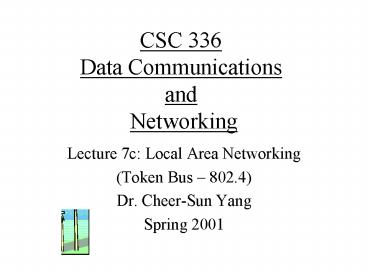CSC 336 Data Communications and Networking - PowerPoint PPT Presentation
1 / 23
Title:
CSC 336 Data Communications and Networking
Description:
Star: A hub or a computer is used to connect to all other computers. ... 4 does not prioritize stations, but it does define priorities for data frames. ... – PowerPoint PPT presentation
Number of Views:34
Avg rating:3.0/5.0
Title: CSC 336 Data Communications and Networking
1
CSC 336Data Communications and Networking
- Lecture 7c Local Area Networking
- (Token Bus 802.4)
- Dr. Cheer-Sun Yang
- Spring 2001
2
(No Transcript)
3
Topologies
- Bus A single communication line, typically a
twisted pair, coaxial cable, or optical fiber,
represents the primary medium. - Ring packets can only be passed from one node to
its neighbor. - Star A hub or a computer is used to connect to
all other computers. - Tree no loop exists (logical connection).
4
Token Bus
- Token Ring (802.5) P. 183, Section 6.3
- Token Bus (802.4) P. 186, Section 6.4
5
(No Transcript)
6
Token Bus vs. Token Ring
- The token bus operates on the sam eprincipal as
the token ring. The stations are organized into a
ring and a token passes among them. A station
wanting to send something must wait for the token
to arrive. - The stations communicate via a common bus in an
Ethernet.
7
Token Bus vs. Token Ring
- Generally, a station receives a token from its
predecessor and sends a token to its successor. - Token bus stations must know their predecessor
and successor.
8
Token Bus vs. Ethernet Bus
- The token bus specifies signals to be sent over a
baseband cable or a broadband cable in one of the
three possible modulation schemes continuous
FSK(baseband), phase coherent FSK(baseband), and
multilevel duobinary AM/PSK(broadband). - Ethernet bus does not use the same modulation
schemes. Ethernet MAC layer protocol is a
contention protocol and there is not token
involved.
9
(No Transcript)
10
Token Bus Operations
- Removing stations
- Adding stations
11
(No Transcript)
12
Lost Tokens
- Claim token frame is sent out is only one station
detects that a token is not received in a
reasonable amount of time. - If more than one station detect this, a
contention-resolving algorithm is invoked.
13
Ring Initialization
- Each station must go through the process of
claiming a token and times out until one station
gets it. - The token passing algorithm is then in effect.
- Each station begins to join the ring.
- Consequently, the station in the ring eventually
sends a solicit successor frame and another
station enters the ring. - Over a period of time solicit successor frames
are sent, thus, allowing all of the waiting
stations to enter the ring.
14
Prioritizing Frames
- The token bus protocol 802.4 does not prioritize
stations, but it does define priorities for data
frames. - Each station maintains four priorities class 0,
class 2, class 4, and class 6. - Class 0 frame has the lowest priority class 6
frame has the highest priority. - When a station gets a token, it sends class 6
frames first. If there are no class 6 data to be
sent, it tries class 4, etc. (Figure 6.23 and
6.24)
15
(No Transcript)
16
(No Transcript)
17
Prioritizing Frames
- Token Holding Time(THT) the maximum time a
station may spend sending class 6 frames. - Token Rotation Time(TRT) the maximum time for a
token to rotate around the ring. It also
determines the maximum time allowed for a station
to send frames in the lower classes.
18
Two Conditions
- Two conditions allow a station to send lower
- priority frames
- If one or more stations do not send the
- maximum number of class 6 frames.
- If TRT gt n THT.
19
(No Transcript)
20
(No Transcript)
21
Priority Performance
- If each station spends the full time allowed by
the THT sending class 6 frames, the token will
take at least n THT time to circulate the ring
once. - Consequently, class 6 frames get 100 of the
buss bandwidth.
22
Priority Performance
- If all stations have the maximum number of class
6 frames to send, we can guarantee a percentage
of bandwidth equal to 100 n THT / TRT for
them. - For example, if we need to guarantee 75 of the
bandwidth for sending class 6 frames, we need to
maintain the relationship of TRT 4n THT/3. - This type of control over the timer adds
flexibility to the token bus in order to adopt to
real-time situations.
23
Reading
- Chapter 6 section 6.4

